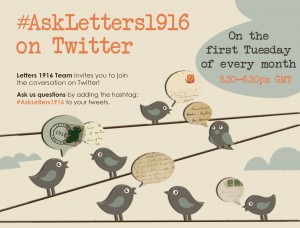
The next #AskLetters1916 Twitter chat will take place on Tuesday 3 March 2015 from 5.30 – 6.30pm (GMT). The chat will be hosted by Vinayak Das Gupta, a PhD student in Trinity College Dublin and will focus on
CURATING THE CROWDSOURCED
by discussing the problems of curating crowd-sourced material and considering issues ranging from captioning to quality of digitized objects.
Modern search engines have made it possible to locate and retrieve information from the vast resources of the internet. Such retrievals of texts, images, sounds etc. are made possible by the envelope of tags and markers that surround the digital object. These markers make the object identifiable to the search engine. In a similar manner, the digitized archival object, whether stored locally on a computer or hosted on a web-server, requires a set of identifiers — the metadata of the object — to make it cognizable and thus accessible within the collection. This layer of information is applied to the object through a combination of human-generated and machine-generated metadata.
Applying metadata to crowd-sourced material is a particularly difficult challenge. The objects acquired from private holdings are familiar to a few, or perhaps forgotten entirely; little information is available about them, and in turn little can be articulated about these objects within the archive. How, then, can we make them visible, not only to the machine, but also, to the user of the archive? The metadata we apply to these artifacts also guide the future uses of the collection. How are we, as creators of digital collections, to speak of the needs of that future user when there is so little we can articulate about the objects themselves?
In 2014, Recalling Jewish Calcutta was completed, a multi-institutional project aimed at collecting the memories of a fading Jewish community in Calcutta, India. While the process of collection started with the small, local Jewish community in the city, over the course of the next months, material from the entire globe was being acquired. These objects — faded photographs from a bygone era — were often without any visible identifiers; the challenge here was to provide at least a basic level of curation to enter them within the collection. The challenge of curating crowd-sourced objects does not end there; beyond the application of metadata, we have to consider the disparate qualities of the digitized material. While some of the acquired data did not meet preservation standards, they were still of archival value.
Join Vinayak and the Letters of 1916 team for what promises to be a fascinating look at curation issues with crowd-sourced content. Tuesday 3 March 2015, 17.30 – 18.30GMT: #AskLetters1916
Tweet the team!
The people behind Letters of 1916 are on Twitter:
Professor Susan Schreibman | Twitter: @schreib100
Karolina Badzmierowska | Twitter: @karolinabadz
William Buck | Twitter: @buck79will
Emma Clarke | Twitter: @clarke__emma
Richard Hadden | Twitter: @oculardexterity
Shane McGarry | Twitter: @irishgeek79
Linda Spinazze | Twitter: @codices_hunter